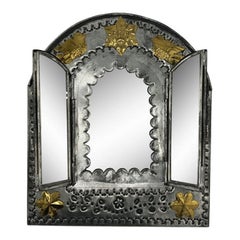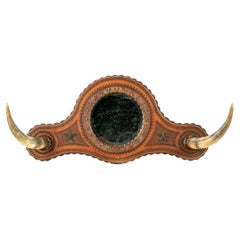Santa Fe Mirrors
Late 20th Century Mexican Folk Art Wall Mirrors
Tin
20th Century American Folk Art Mirrors
Horn, Leather
People Also Browsed
2010s Danish Scandinavian Modern Dining Room Chairs
Oak
21st Century and Contemporary French Modern Benches
Steel
21st Century and Contemporary Asian Modern Dining Room Tables
Wood
21st Century and Contemporary Mexican Organic Modern Table Lamps
Brass
2010s Swiss Black Forest Mirrors
Other
Vintage 1930s Mexican Art Deco Chandeliers and Pendants
Milk Glass
Antique Mid-19th Century French Louis XVI Pedestals and Columns
Wood
Vintage 1930s Mexican Art Deco Credenzas
Pine
Early 20th Century English Country Wall Mirrors
Antler, Wood
Late 20th Century Mid-Century Modern Console Tables
Marble
Vintage 1980s Mexican International Style Floor Lamps
Metal
Antique Late 19th Century Swiss Black Forest Animal Sculptures
Wood
Antique 19th Century Mexican Spanish Colonial Tables
Pine, Paint
Vintage 1930s English Rococo Revival Table Mirrors
Antique Late 19th Century Swiss Black Forest Animal Sculptures
Wood
Antique Mid-18th Century Mexican Spanish Colonial Trunks and Luggage
Upholstery, Wood
A Close Look at Folk Art Furniture
Folk art is a genre of art that shares the creator’s traditions, offering not just an artistic display but an opportunity to learn about a culture. Antique, new and vintage folk art typically reflects a heritage or location. It can include utilitarian objects and handmade art as diverse as weather vanes, duck decoys, portraiture and paintings, carnival art and quilts.
Quilts are a quintessential part of American folk art but their roots are international, with quilting dating back to Ancient Egypt. The practice spread to Europe and was especially prominent in the Middle Ages, with one of the oldest surviving examples being the Tristan quilt made in Sicily in the 14th century. They were made as bedcovers and clothing, including as a layer for knights to wear beneath their armor. Native American folk art includes functional objects reflecting their heritage, such as baskets, textiles and wooden pieces.
Elsewhere, the vast range of work associated with Mexican folk art includes masks made by Mexican craftspeople for traditional celebrations and ceremonial dances. Mexican masks are part of the country’s folk-art traditions that go back thousands of years and play a role in festivals and theater.
Works in the folk art tradition are valuable because of the skills involved, like weaving, hand-carving wood and even stonework. Many folk artists are self-taught, while some train as apprentices within their community. By using available materials and taking a personal approach to their creations, artists ensure each piece is unique and conveys a story.
During the Great Depression, artistic materials in America were hard to come by, so artisans used discarded wood from cigar boxes and shipping crates to make highly stylized, notched pieces — most often picture frames and boxes — that are today sought after by collectors. This folk art style is called tramp art and was popular from roughly 1870 until the 1940s.
Folk art brings vibrant culture and traditions into your home. Browse an extensive collection of antique, new and vintage folk art on 1stDibs.
Finding the Right Mirrors for You
The road from early innovations in reflective glass to the alluring antique and vintage mirrors in trendy modern interiors has been a long one but we’re reminded of the journey everywhere we look.
In many respects, wall mirrors, floor mirrors and full-length mirrors are to interior design what jeans are to dressing. Exceedingly versatile. Universally flattering. Unobtrusively elegant. And while all mirrors are not created equal, even in their most elaborate incarnation, they're still the heavy lifters of interior design, visually enlarging and illuminating any space.
We’ve come a great distance from the polished stone that served as mirrors in Central America thousands of years ago or the copper mirrors of Mesopotamia before that. Today’s coveted glass Venetian mirrors, which should be cleaned with a solution of white vinegar and water, were likely produced in Italy beginning in the 1500s, while antique mirrors originating during the 19th century can add the rustic farmhouse feel to your mudroom that you didn’t know you needed.
By the early 20th century, experiments with various alloys allowed for mirrors to be made inexpensively. The geometric shapes and beveled edges that characterize mirrors crafted in the Art Deco style of the 1920s can bring pizzazz to your entryway, while an ornate LaBarge mirror made in the Hollywood Regency style makes a statement in any bedroom. Friedman Brothers is a particularly popular manufacturer known for decorative round and rectangular framed mirrors designed in the Rococo, Louis XVI and other styles, including dramatic wall mirrors framed in gold faux bamboo that bear the hallmarks of Asian design.
Perhaps unsurprisingly, mid-century modernism continues to influence the design of contemporary mirrors. Today’s simple yet chic mantel mirror frames, for example, often neutral in color, owe to the understated mirror designs introduced in the postwar era.
Sculptor and furniture maker Paul Evans had been making collage-style cabinets since at least the late 1950s when he designed his Patchwork mirror — part of a series that yielded expressive works of combined brass, copper and pewter — for Directional Furniture during the mid-1960s. Several books celebrating Evans’s work were published beginning in the early 2000s, as his unconventional furniture has been enjoying a moment not unlike the resurgence that the Ultrafragola mirror is seeing. Designed by the Memphis Group’s Ettore Sottsass in 1970, the Ultrafragola mirror, in all its sensuous acrylic splendor, has become somewhat of a star thanks to much-lauded appearances in shelter magazines and on social media.
On 1stDibs, we have a broad selection of vintage and antique mirrors and tips on how to style your contemporary mirror too.
- 1stDibs ExpertJanuary 27, 2025There are several famous Santa Fe potters. The capital city is well-known for studios and shops that sell the works of Indigenous potters, and some of these artisans have become especially acclaimed for their work. Among them are Tony Da, Maria Martinez, Lucy Lewis, Nampeyo, Margaret Tafoya, Rose Gonzales, Susana Martinez Aguilar, Ramona Sanchez Gonzales, Juanita Gonzales and Louis “Wo-Peen” Gonzales. Find a selection of pottery on 1stDibs.

